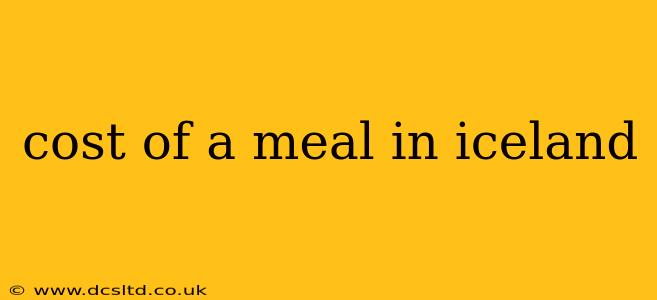Iceland, a land of fire and ice, offers breathtaking landscapes and a unique cultural experience. However, one aspect that often surprises visitors is the cost of living, particularly the price of food. This guide will break down the cost of a meal in Iceland, considering various dining options and factors influencing the overall expense. Understanding these factors will help you budget effectively and enjoy your Icelandic culinary adventure without breaking the bank.
What Factors Influence Meal Prices in Iceland?
Several factors significantly impact the cost of a meal in Iceland:
- Location: Prices in Reykjavik, the capital city, tend to be higher than in smaller towns and rural areas. Tourist hotspots also command premium prices.
- Type of Restaurant: Fine dining establishments, upscale restaurants, and those located in prime tourist areas will naturally be more expensive than casual eateries, local diners, or street food vendors.
- Type of Meal: A simple hot dog will cost considerably less than a multi-course meal at a Michelin-recommended restaurant.
- Season: Prices may fluctuate slightly depending on the season, with peak tourist seasons potentially seeing higher prices.
- Currency Exchange Rates: The current exchange rate between your home currency and the Icelandic króna (ISK) will directly affect the final cost.
How Much Does a Meal Cost in Iceland? A Breakdown
Here's a realistic breakdown of meal costs in Iceland across different dining scenarios:
Budget-Friendly Options (ISK 2,000 - 4,000 or ~$15 - $30 USD):
- Hot Dogs: Icelandic hot dogs are a popular and affordable option, readily available from street vendors and gas stations. Expect to pay around ISK 1,000-1,500 per hot dog.
- Soup: Many cafes and restaurants offer affordable soups, often featuring local ingredients.
- Sandwiches: Pre-made sandwiches from convenience stores or bakeries are another budget-friendly choice.
- Self-Catering: Grocery shopping and preparing your meals is the most economical way to eat in Iceland.
Mid-Range Options (ISK 4,000 - 8,000 or ~$30 - $60 USD):
- Casual Restaurants: Expect to pay this range for a main course at a casual restaurant, pub, or cafe. This could include traditional Icelandic dishes or international cuisine.
- Cafes: Cafes offer a range of options, from sandwiches and salads to lighter meals.
Upscale Dining (ISK 8,000+ or ~$60+ USD):
- Fine Dining Restaurants: Expect to pay significantly more for a fine dining experience, with prices per person often exceeding ISK 10,000.
What are the cheapest places to eat in Iceland?
Budget-Conscious Eats:
- Grocery Stores: Shopping at grocery stores like Bonus, Krónan, or Netto is the most economical option. You can find a wide selection of affordable ingredients for self-catering.
- Street Food: Hot dog stands are a quintessential Icelandic experience and are budget-friendly.
- Bakeries: Bakeries offer pastries, sandwiches, and soups at reasonable prices.
Where can I find affordable meals near popular tourist attractions?
Finding affordable meals near tourist attractions can be challenging, as prices often inflate in these areas. However, venturing slightly away from the main tourist hubs can often yield more budget-friendly options. Look for local eateries and cafes frequented by locals rather than focusing solely on restaurants in the most heavily trafficked areas.
What are some typical Icelandic dishes and their average cost?
Icelandic cuisine incorporates fresh, local ingredients. Some popular dishes include:
- Plokkfiskur (Fish Stew): A hearty and flavorful stew, usually found in the mid-range price bracket.
- Skyr: A type of yogurt, often served with berries or granola, available at various price points.
- Hangikjöt (Smoked Lamb): A traditional Icelandic dish, typically more expensive, found in higher-end restaurants.
How can I save money on food in Iceland?
- Self-Cater: This remains the most effective method of keeping food costs down.
- Utilize Grocery Stores: Take advantage of discounted supermarket items and plan your meals accordingly.
- Happy Hour Deals: Some restaurants offer happy hour specials on food and drinks.
- Look for Lunch Menus: Lunch menus often offer more affordable options than dinner menus.
- Pack Snacks: Pack snacks and drinks to avoid impulse purchases throughout the day.
By understanding the factors influencing meal costs and utilizing these tips, you can savor Iceland's culinary offerings while managing your budget effectively. Remember that while Iceland can be expensive, careful planning can allow you to enjoy delicious food without compromising your travel experience.
